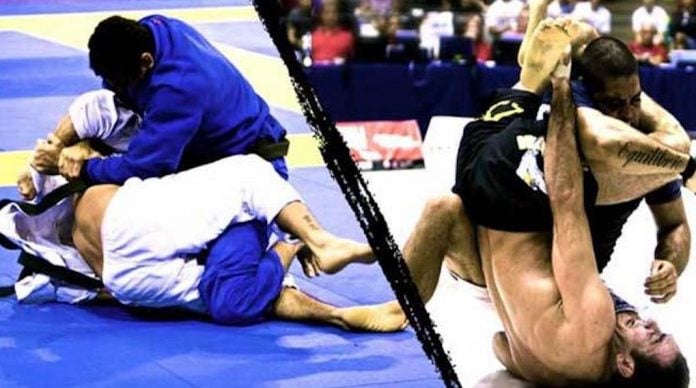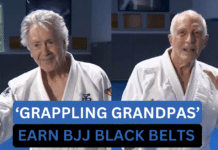
In the modern world of BJJ, there are two main streams of practicing the art. One employs the use of a traditional Gi, along with a certain ruleset some frown upon. That is Gi Jiu-Jitsu. The other often deemed more fun and free-thinking, revolves around wrestling in spats and a rashguard. This is known as No-Gi Jiu-Jitsu. Both of these streams have die-hard proponents who blatantly refuse to recognize the value of the other.
In the modern era, though, it is hard to present a certain thing in a negative sense. People have research tools at their disposal that weren’t there just a few decades ago. Back in the old days, No-Gi Jiu-Jitsu was often ostracized, thanks to propaganda. In fact, the original BJJ practitioners didn’t wear a Gi only when it was too hot to train in one. And, in some instances, while training or competing in Shoot Boxing. Since then, No-Gi has spread onto the BJJ scene, offering a new perspective for both amateur and professional athletes. Let’s put No-Gi Jiu-Jitsu on trial and decide whether it is really as fun and effective as presented?
The Case For No-Gi Jiu-Jitsu
First and foremost, let’s look at the very basics of No-Gi Jiu-Jitsu training. The most obvious difference compared to traditional BJJ is that of the training attire. Most people involved in No Gi nowadays favor wearing rash guards. Earlier in No Gi’s development, most people went for shorts and a shirt, or shorts only. As insignificant as this might seem, shedding the Gi actually changes the game a lot.
Namely, without the Gi, there are no more collars, sleeves, or pants to grab on to. Traditional BJJ is immensely dependent on these basic grip points for control. The whole game of GI BJJ is based around controlling, and even attacking an opponent with parts of the kimono. The grips in No-Gi are closer to those of submission wrestling, for example. Head control, with one or two arms and gripping the wrists are the two main avenues of control in No-Gi. People like Jean Jacques Machado, who was born with four fingers missing on one of his arms, proved how effective these grips can be. Although seemingly not as tight as Gi grips, they do offer a different way of approaching BJJ.
Furthermore, the inherent ‘lack” of control leads to a higher pace of No-Gi matches. This means that people are sharper, more prone to quick transitioning, and have to be masters of weight distribution.
The rules, although variable from one organization to another, also revolves around the nature of the No-Gi game. No-Gi Jiu-Jitsu rulesets allow for a greater variety of techniques to be employed. Some of these techniques are forbidden under Gi rules, which is another point of disagreement. ADCC competition has proved how entertaining BJJ can be without the risk of added injuries. In recent years, EBI-style tournaments only confirmed that.
The Case Against No Gi Jiu Jitsu
The case against No-Gi Jiu-Jitsu starts with the absence of control. Since BJJ is essentially the game of controlling an opponent, it is understandable why some have this approach. the Gi does offer way more in terms of control, thus opening more opportunities for attack. While No-Gi revolves around wrestling-style controls, Gi Jiu-Jitsu allows for more creativity in this department. Just check out some of the latest lapel-based guard systems and you’ll see how deep BJJ can go.
Having greater control over an opponent means that you can attack from more positions. There are way more sweeps available in Gi Jiu Jitsu, as well as guard variations . The gripping practices of No Gi are transferable to Gi practice, while the opposite doesn’t hold true.
Thus, Gi Jiu-Jitsu is considered to be more technical than No-Gi, whose fast pace means that the style revolves around submission hunting rather than slow control. It is a fact that although the belt system is applicable to both streams, Gi Jiu-Jitsu is considered the best way to get a black belt. One can see why this holds merit, given the wealth of technical knowledge required to battle in the versatility of the Gi.
The Verdict
All in all, the case seems to be closely tied. The determining factors of the verdict come down to two aspects – persona preference and approach to BJJ. In the first category, personal preference dictates whether one will wear a Gi over their rash guard. Since personal preference can hardly be influenced, we come to the approach one has to Jiu-Jitsu. Here, before a student develops their own philosophy of BJJ, they are introduced to the basics by instructors. Instructors’ personal preferences do influence those of students a lot, so instructors have to be careful to present the art without bias.
Finally, I think that the best way to bring this to an end is through a settlement. Students should become as proficient in No-Gi, as they are in Gi Jiu-Jitsu. This is the only way to ensure that every Jiu-Jitsu match is fun and entertaining. As far as fun in training, if you think Gi Jiu-Jitsu is boring, apply No-Gi principles while rolling and create an environment that suits you.
https://bjj-world.com/danaher-philosophy-jiu-jitsu/
Royce Gracie: I won’t Teach my Students Anything that Doesn’t Work on the Street


![Darce Choke Encyclopedia – Origins, Mechanics and Variations [2024] BJJ, choke, Brabo, BJJ Darce Choke, D'arce Choke, Darce BJJ Choke](https://bjj-world.com/wp-content/uploads/2017/11/JungPoirierLeeYahoo-218x150.jpg)










![Best Marcelo Garcia Techniques by Team Marcelo Garcia DVD Review [2025] Best Marcelo Garcia Techniques by Team Marcelo Garcia DVD Review](https://bjj-world.com/wp-content/uploads/2025/02/best-marcelo-garcia-techniques-dvd-review-218x150.png)
![Forging The De La Riva Guard Giancarlo Bodoni DVD Review [2025]](https://bjj-world.com/wp-content/uploads/2025/02/de-la-riva-guard-giancarlo-bodoni-dvd-review-218x150.png)

![Breaking Their Guard Mikey Musumeci DVD Review [2025] Breaking Their Guard Mikey Musumeci DVD Review](https://bjj-world.com/wp-content/uploads/2025/02/breaking-their-guard-mikey-musumeci-dvd-review-218x150.png)

![Charles Allan Price Building Workouts For BJJ DVD Review [2024] Charles Allan Price Building Workouts For BJJ DVD Review](https://bjj-world.com/wp-content/uploads/2024/09/charles-allan-price-building-workouts-for-bjj-review-324x235.png)

![Bricks Kesa Gatame System Jeremy Brick DVD Review [2025] Bricks Kesa Gatame System Jeremy Brick DVD Review](https://bjj-world.com/wp-content/uploads/2025/02/bricks-kesa-gatame-system-jeremy-brick-dvd-review-100x70.png)


![Top Half Guard Neil Melanson DVD Review [2025] Top Half Guard Neil Melanson DVD Review](https://bjj-world.com/wp-content/uploads/2025/02/top-half-guard-neil-melanson-dvd-review-100x70.png)

![Spider and Lasso Guard Jared Welman DVD Review [2025] Spider and Lasso Guard Jared Welman DVD Review](https://bjj-world.com/wp-content/uploads/2025/01/spider-and-lasso-guard-jared-welman-dvd-review-100x70.png)




![Assassin Choke Baret Yoshida DVD Review [2024] Assassin Choke Baret Yoshida DVD Review](https://bjj-world.com/wp-content/uploads/2024/10/assassin-choke-baret-yoshida-dvd-review-100x70.png)


![The Closed Guard Malachy Friedman BJJ DVD Review [2025] The Closed Guard Malachy Friedman BJJ DVD Review](https://bjj-world.com/wp-content/uploads/2025/01/closed-guard-malachy-friedman-bjj-dvd-review-100x70.png)

![Reverse Armlock Magid Hage DVD Review [2024] Reverse Armlock Magid Hage DVD Review](https://bjj-world.com/wp-content/uploads/2024/12/reverse-armlock-magid-hage-dvd-review-100x70.png)
![Crush The Guard Vagner Rocha DVD Review [2024] Crush The Guard Vagner Rocha DVD Review](https://bjj-world.com/wp-content/uploads/2024/10/crush-the-guard-vagner-rocha-dvd-review-100x70.png)
![Slay The Wrestle Up Guard Nick Rodriguez DVD Review [2024] Slay The Wrestle Up Guard Nick Rodriguez DVD Review](https://bjj-world.com/wp-content/uploads/2024/12/slay-the-wrestle-up-guard-nick-rodriguez-dvd-review-100x70.png)

![Advanced Immortal Clinch Matt Brown DVD Review [2024] Advanced Immortal Clinch Matt Brown DVD Review](https://bjj-world.com/wp-content/uploads/2024/09/advanced-immortal-clinch-matt-brown-dvd-review-100x70.png)

![Flow Pressure Kauan Barboza DVD Review [2025] Flow Pressure Kauan Barboza DVD Review](https://bjj-world.com/wp-content/uploads/2025/02/flow-pressure-kauan-barboza-dvd-review-100x70.png)
![Gracie Secrets Closed Guard Kyra Gracie DVD Review [2024] Gracie Secrets Closed Guard Kyra Gracie DVD Review](https://bjj-world.com/wp-content/uploads/2024/12/closed-guard-kyra-gracie-dvd-review-100x70.png)



![Tricks for Unstoppable Takedowns Georges St Pierre DVD Review [2024] Tricks for Unstoppable Takedowns Georges St Pierre DVD Review](https://bjj-world.com/wp-content/uploads/2024/12/unstoppable-takedowns-georges-st-pierre-dvd-review-100x70.png)
